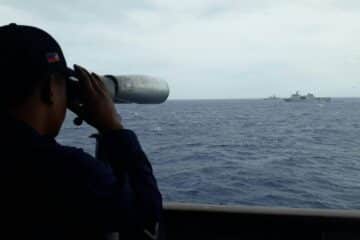Swedish amred forces press release – Translated by Naval News
On June 8, exactly twenty years ago HMS Visby was launched at what was then the Karlskrona Shipyard. A major technological leap for the Navy.
Twenty years later, the crew is learning new ways to use the ship tactically. A good tribute for the design and for those who designed and built the ship. It’s a ship like no other. Its unique shape, of course, is to reduce the radar signature and make it harder to detect. But it’s not just the radar signature that is attenuated. The stealth technology on board is uncompromising. The ship is also stealthily adapted to acoustics (sound), magnetism, IR (thermal radiation) and several other areas.
Thomas Zimmerman has been the commander of HMS Nyköping for three years and has spent about a decade on board in various positions:
“We continue to develop our tactics and the way we use the ship, twenty years after its launch. We are constantly improving and in this way we are growing with the capabilities of the ship.”

Internationally appreciated
The five corvettes have been tested in the Mediterranean and Arctic environments north of Norway. The corvettes are adapted to Swedish conditions, and that’s where they are the best. When various exercises are conducted with Sweden’s international partners, the Visby-class adds a capability that they lack.
Visby-class corvettes are often tasked with littoral missions, acting as a link between the larger vessels offshore and units deployed on the shoreline. But the Visby vessels have also shown that the can work on the high seas, such as when they hunted submarines in the North Atlantic during the Trident Juncture exercise 2018.
The future of the Visby-class

Over the next few years, new weapon systems will replace the old ones. These include a new long-range anti-ship missile, a new torpedo and, hopefully, the addition of an air defence missile capability. At the same time, the mid-life update of the Visby-class is approaching.
In the external environment that has been deteriorating for some time, vessels of the Swedish Navy have been put hard to work during exercises, deployments and, above all, constant surveillance of the sea. With few vessels and many tasks, the equipment is getting worn and that is becoming noticeable. A mid-term change would be welcome.
-End-
About Visby-class stealth corvette

The five Visby-class corvettes were built by Kockums in Karlskrona between 2000 and 2009. Their tasks are anti-surface warfare (ASuW), anti-submarine warfare (ASW), escort and mine clearance. The vessels belong to the 3rd and 4th Naval Warfare Flotilla (sjöstridsflj) of the Swedish Navy.
Those ships are iconic and famous globally for their unique stealth design. Most of the sensors are covered by the hull and the main gun is hidden in a stealthy cupola when not in use. Even the anti-ship missile launchers are hidden internally in the ship’s structure. The exhaust gases from the ship’s water jet propulsion engines are diverted through hidden outlets near the waterline to provide as little heat signature as possible.
Three out of five corvettes have the ability to receive an organic helicopter. The mid size (A109M type) helicopter can land, take off, and refuel on the upper deck, but on temporarily as there is no hangar to protect it.
Visby-class specifications
Length: 73 m
Width: 10.4 m
Height: 19.3 m
Displacement: 640 tons
Max speed: About 35 knots
Propulsion: Water jet ; diesel 2,600 kW; gas turbines 16,000 kW
Crew: 43 sailors
Weapon systems: Bofors 57 mm Mk III (stealth variant), Saab RBS 15 Mk II anti-ship missiles, submarine torpedoes, Torped 45 torpedoes.
Sensor systems: Saab Sea GIRAFFE AMB 3D PESA surveillance radar, Saab Ceros 200 stealth fire control radar system, Condor CS-3701 tactical radar surveillance system, GDC Hull-mounted sonar
Hydroscience Technologies towed array sonar system, GDC variable depth sonar





